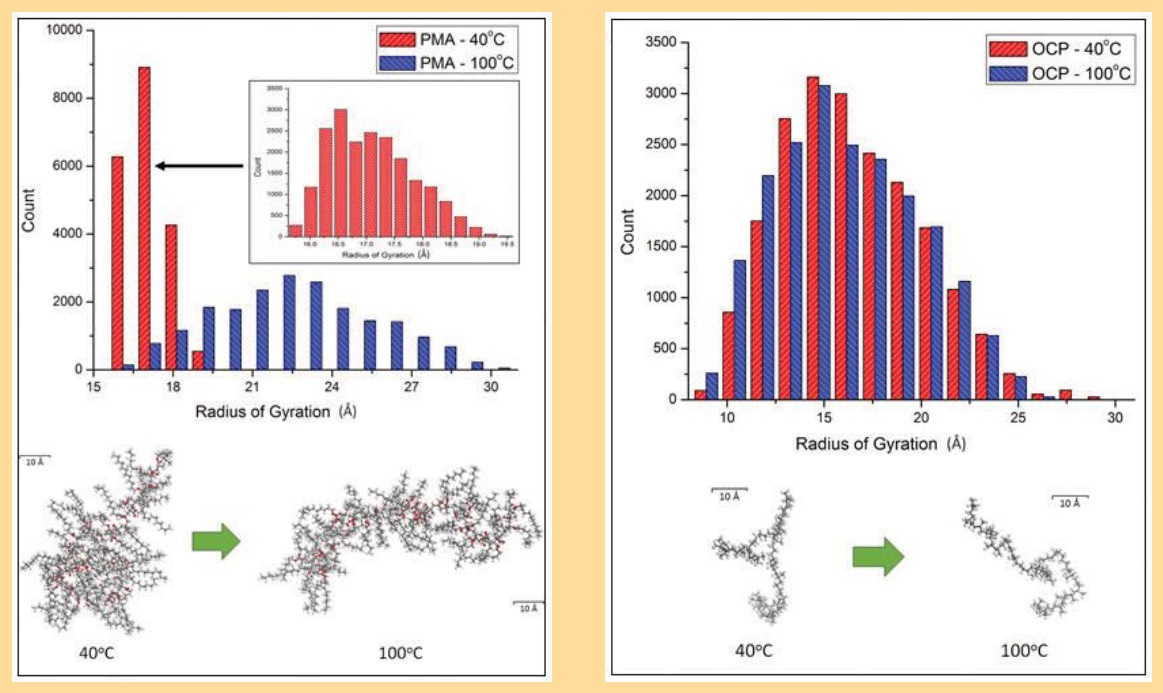Coils in oils
Drs. Wilfred T. Tysoe & Nicholas D. Spencer | TLT Cutting Edge August 2016
It is widely believed that polymeric viscosity index improvers work by expanding their coil size at higher temperatures. MD simulations show that life is not so simple.
VISCOSITY-INDEX (VI) IMPROVERS ARE ADDED TO LUBRICANTS to resist the tendency of oils to lower their viscosity upon increasing temperature. This, in turn, improves energy efficiency in engines at lower temperatures because lower-viscosity oils can be used without the fear that the viscosity will then be too low to maintain fluid-film lubrication at higher temperatures. These additives are typically high-molecular-weight polymers, such as olefin copolymers (OCPs) or polyalkylmethacrylates (PMAs).
Selby put forward a potential mechanism for the functioning of VI improvers in 1958 (
1), which is still widely believed, although there is no direct evidence that it is generally applicable. He suggested that at lower temperatures the polymer chain is tightly coiled and contributes little to the oil’s viscosity. However, as its solubility in the oil improves at higher temperatures, it expands upon heating, increasing the viscosity of the oil-polymer solution and compensating for the viscosity decrease normally seen for the oil at higher temperatures. In fact, recent, small-angle neutron-scattering experiments (
2) have shown that while certain VI improvers (such as PMAs) show an increase in their coil sizes, or radii of gyration (R
g) upon heating, others (such as OCPs) do not. However, it also has been suggested that VI improvers with an R
g that increases with temperature appear to be more effective.
STLE Board member professor Ashlie Martini and STLE-member Uma Shantini Ramasamy, of the University of California-Merced, together with their colleague Professor Seth Lichter of Northwestern University, have addressed this interesting issue by means of molecular-dynamics simulations. They modeled the behavior of several 50-repeat-unit polymers dissolved in dodecane, as the temperature of the solutions was increased (
3). As representatives of PMA and OCP, they chose poly(dodecyl methacrylate) and poly(ethylene-
ran-propylene) (in which the ethylene and propylene are randomly distributed), respectively. Interestingly, while the R
g of the PMA increased significantly upon increasing temperature from 40 C to 100 C, the R
g of the OCP actually decreased a little (
see Figure 1), confirming the neutron-scattering results.
 Figure 1. Frequency histograms of Rg and typical molecular configurations for PMA (left) and OCP (right) at 40 C and 100 C.
Figure 1. Frequency histograms of Rg and typical molecular configurations for PMA (left) and OCP (right) at 40 C and 100 C.
The modelers extended their study to investigate whether the differences between OCP and PMA were due either to the long side-chains (present in the PMA, but not in the OCP) or the presence of oxygen (present in the PMA, but not in the OCP). In the case of poly(methyl methacrylate) (PMMA), which resembles poly(dodecyl methacrylate) but without the long side-chains, they found that its R
g did, in fact, increase upon heating to a similar extent to that seen for the PMA. Thus, the side chains appear not to be responsible for the expansion. They then modeled a polymer that resembled PMMA but with –CH
2– groups replacing the oxygen atoms in the carbonyl and ester groups. In this case, the polymer contracted with temperature, as was the case for the OCP. It therefore appears that it is the presence of oxygen in the polymers, rather than the long side-chains, that affects their expansion behavior upon heating.
Molecular-dynamics simulations seem to be a very useful approach in the molecular design of new, effective VI improvers, which can contribute to the ongoing development of new generations of energy-efficient lubricants.
REFERENCES
1.
Selby, T.W. (1958), “The non-Newtonian characteristics of lubricating oils,”
ASLE Trans,
1, pp. 68-81.
2.
Covitch, M.J. and Trickett, K.J. (2015), “How polymers behave as viscosity-index improvers in lubricating oils,”
Adv. Chem. Eng. Sci.,
5, pp. 134-151.
3.
Ramasamy, U.S., Lichter, S. and Martini, A. (2016), “Effect of molecular-scale features on the polymer coil size of model viscosity index improvers,”
Trib. Lett.,
62, p. 23.
 Eddy Tysoe (left) is a distinguished professor of physical chemistry at the University of Wisconsin-Milwaukee. You can reach him at wtt@uwm.edu
Eddy Tysoe (left) is a distinguished professor of physical chemistry at the University of Wisconsin-Milwaukee. You can reach him at wtt@uwm.edu.
Nic Spencer (right) is professor of surface science and technology at the ETH Zurich, Switzerland. You can reach him at nspencer@ethz.ch.
Both serve as editors-in-chief of STLE-affiliated Tribology Letters journal.